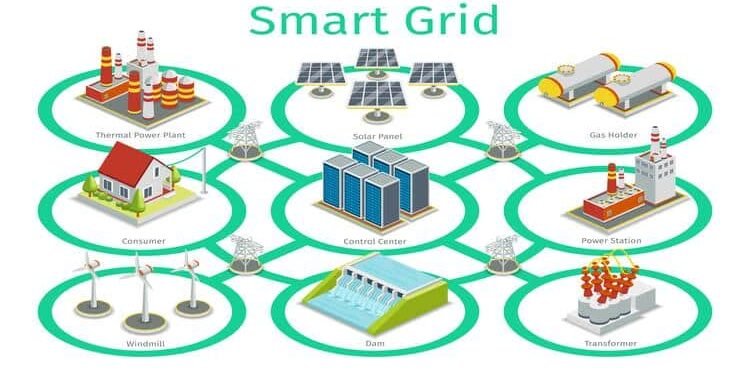In today’s rapidly evolving world, the demand for energy is surging, driven by population growth, urbanization, and industrialization. As a result, there is a pressing need to transform our traditional power grids into smarter and more resilient systems. Smart grids combine digital technologies, advanced communication networks, and intelligent devices to enable efficient two-way communication between utilities and consumers. By integrating real-time data, automation, and renewable energy sources, smart grids revolutionize the way electricity is generated, transmitted, distributed, and consumed.
What is a Smart Grid?
A smart grid is an intelligent electricity distribution network that leverages advanced technologies to optimize the generation, transmission, and consumption of energy. Unlike conventional grids, smart grids enable a bidirectional flow of electricity and information, allowing for dynamic monitoring, control, and communication between various components of the grid. By utilizing sensors, meters, and smart devices, a smart grid provides real-time data on energy consumption, identifies inefficiencies, and offers actionable insights to improve system performance.
Components of a Smart Grid
- Advanced Metering Infrastructure (AMI): The foundation of a smart grid lies in its advanced metering infrastructure. Smart meters enable real-time monitoring of energy consumption and facilitate two-way communication between consumers and utilities. This empowers consumers to make informed decisions about their energy usage and enables utilities to optimize load management and billing processes.
- Distribution Automation: Smart grids employ automation technologies to enhance the reliability and efficiency of power distribution. Automated switches, sensors, and control systems detect faults, isolate affected areas, and restore power supply faster than traditional manual methods. This minimizes downtime during outages and improves system performance.
- Demand Response: Smart grids enable demand response programs, which incentivize consumers to adjust their energy usage during peak demand periods. By offering financial incentives or rebates, utilities can reduce strain on the grid during high-demand periods and maintain a balance between electricity supply and demand.
- Renewable Energy Integration: One of the key advantages of smart grids is their ability to seamlessly integrate renewable energy sources into the grid. By intelligently managing the variability and intermittency of renewable energy generation, smart grids enable higher penetration of clean energy and reduce reliance on fossil fuels.
- Energy Storage: Smart grids facilitate the integration of energy storage systems, such as batteries, into the grid infrastructure. Energy storage helps mitigate the challenges associated with intermittent renewable energy generation by storing excess energy during low-demand periods and releasing it during high-demand periods. This improves grid stability, reduces peak load requirements, and enhances overall system efficiency.
Benefits of a Smart Grid
- Enhanced Energy Efficiency
Smart grids promote energy efficiency by providing real-time data on energy consumption, allowing consumers to monitor and adjust their usage patterns accordingly. With access to detailed information about their energy consumption and costs, consumers can make informed decisions to reduce wastage and optimize their energy usage. Additionally, smart grids enable utilities to identify and rectify inefficiencies in the distribution system, further improving overall energy efficiency.
- Improved Grid Reliability
Traditional power grids are susceptible to failures, resulting in frequent blackouts and voltage fluctuations. Smart grids minimize such disruptions by continuously monitoring the grid’s health and promptly detecting faults or abnormalities. Automated systems can isolate faulty sections, reroute power supply, and restore service in a timely manner. This enhanced reliability ensures an uninterrupted power supply, minimizing inconvenience for consumers and businesses.
- Integration of Renewable Energy
The integration of renewable energy sources is a critical aspect of transitioning to a sustainable energy future. Smart grids facilitate the smooth integration of solar, wind, and other renewable energy sources into the grid infrastructure. By intelligently managing the variability and intermittency of renewable generation, smart grids optimize the utilization of clean energy, reducing greenhouse gas emissions and dependence on fossil fuels.
- Cost Savings for Consumers
Smart grids empower consumers to make informed decisions about their energy usage, leading to potential cost savings. Real-time data on energy consumption and pricing enables consumers to adjust their energy usage patterns during peak demand periods when electricity prices are higher. By actively participating in demand response programs and shifting energy-intensive tasks to off-peak hours, consumers can reduce their electricity bills and save money.
- Reduced Environmental Impact
Traditional power generation methods contribute to air and water pollution, as well as climate change. Smart grids promote the adoption of renewable energy sources, which have a lower environmental footprint compared to fossil fuel-based generation. By integrating clean energy sources and optimizing their utilization, smart grids help reduce greenhouse gas emissions, minimize environmental degradation, and contribute to a greener and more sustainable planet.
- Empowering Consumers
Smart grids empower consumers by providing them with greater control over their energy usage. Real-time energy consumption data, delivered through smart meters and mobile applications, allows consumers to monitor their usage, set energy-saving targets, and track their progress. This transparency fosters energy-conscious behavior, encourages conservation, and promotes a culture of sustainability among consumers.
- Better Outage Management
When power outages occur, smart grids offer improved outage management capabilities. By quickly identifying the location and cause of the outage, automated systems can isolate the affected area and reroute the power supply, minimizing the impact on unaffected areas. Additionally, smart grids provide real-time status updates to utilities, enabling faster response times and efficient restoration of power.
- Enhanced Cybersecurity
As the energy sector becomes more digitized, ensuring cybersecurity is of paramount importance. Smart grids employ robust cybersecurity measures to protect against cyber threats and safeguard critical infrastructure. By implementing encryption, authentication, and intrusion detection systems, smart grids ensure the confidentiality, integrity, and availability of data, protecting against unauthorized access and potential disruptions.
Future Outlook and Expansion
The future of smart grids is promising, with continuous advancements in technology and an increasing focus on sustainability. As renewable energy generation continues to grow, smart grids will play a vital role in managing the variability and integrating clean energy into the grid. Further developments in energy storage technologies will enhance grid stability and support the wider adoption of intermittent renewables. The expansion of smart grid systems across cities, regions, and countries will lead to a more interconnected and efficient global energy network.
Smart grids are revolutionizing the way electricity is generated, transmitted, distributed, and consumed. By leveraging advanced technologies, data analytics, and renewable energy integration, smart grids offer a range of benefits, including enhanced energy efficiency, improved grid reliability, cost savings for consumers, and reduced environmental impact. Despite the challenges and limitations, the advantages of smart grids outweigh the upfront costs and complexities associated with their implementation. As we strive toward a more sustainable and efficient energy future, smart grids will play a pivotal role in achieving our goals.









